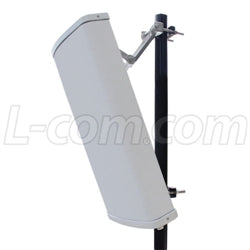The Benefits of using a Cross-Polarized Antenna
Received signals at base station antennas tend to be elliptically polarized in a way that more closely resembles vertical polarization than horizontal polarization. This creates a common problem with dual polarized base station antennas as the vertically polarized antenna element generally provides a stronger receive signal than the horizontally polarized antenna element.
This can be corrected by slanting the orthogonal polarized antenna elements to plus or minus 45 degrees. By slanting one of the antenna elements 45 degrees to the left and the other 45 degrees to the right, improved equality in received signal levels can be achieved. This can help improve coverage in urban environments.
Another advantage to using these types of cross polarized antennas is in co-located wireless system installations. Since multiple antennas are used within the same facility or tower, this often gives interference issues among antennas which are usually vertically or horizontally polarized. Using 45 degree slanted cross polarized antennas on the client side as well on the base station side can greatly reduce interference and improve overall performance.
Some of L-com's antennas also feature spatial diversity in addition to being cross-polarized. This is useful for operating in areas susceptible to the effects of multi-path interference. By providing spatial diversity, the radio's internal circuitry can select between the two receive antennas for better wireless reception.
In the case of 802.11n or MIMO applications, two or more spatially or polarization diverse antennas are required for the radio to operate at its highest data rate.

